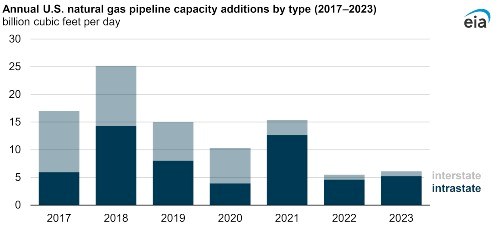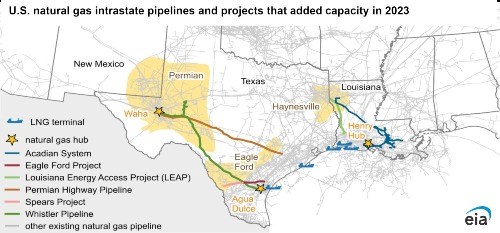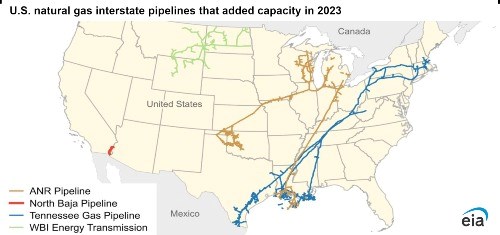Natural gas intrastate pipeline capacity additions outpaced interstate additions in 2023

Data source: U.S. Energy Information Administration, Natural Gas Pipeline Projects Tracker
Note: Interstate pipelines are pipelines that cross state and international borders and are regulated by the Federal Energy Regulatory Commission. Intrastate pipelines are pipelines within a state that do not cross state borders and are regulated by a state agency. Intrastate capacity additions also include projects associated with interstate pipelines that do not cross state borders.
In 2023, 5.2 billion cubic feet per day (Bcf/d) of natural gas intrastate pipeline capacity was added in the United States, according to our recently updated Natural Gas Pipeline Projects Tracker. Intrastate pipelines are within a single state (that is, they do not cross state lines) and are regulated by state agencies. Interstate pipelines cross state and international borders and are regulated by the Federal Energy Regulatory Commission (FERC).
Interstate pipeline capacity additions have declined since 2018 and totaled less than 1.0 Bcf/d last year. New capacity on pipelines crossing state lines accounted for 14% of total new capacity in 2023 compared with 65% in 2017.
Nearly all the intrastate pipeline capacity additions in 2023 were located in Texas and Louisiana to serve natural gas demand in U.S. Gulf Coast markets, including liquefied natural gas (LNG) export demand.

Data source: U.S. Energy Information Administration and company press
Note: LNG=liquefied natural gas
Intrastate projects included:
- Enterprise Products Partners’ Acadian Haynesville Extension: A 0.4 Bcf/d capacity expansion with added compression on the Acadian System, which delivers natural gas from the Haynesville producing region in northwestern Louisiana to U.S. Gulf Coast markets
- Kinder Morgan’s Eagle Ford Project: A new 2.0 Bcf/d pipeline that begins at the Kinder Morgan Texas Pipeline compressor station in Freer, Texas; extends to the Kinder Morgan Tejas Pipeline system near Sinton, Texas; and delivers natural gas from the Eagle Ford producing region to U.S. Gulf Coast markets
- DTE Midstream’s Louisiana Energy Access Project (LEAP) Expansion Phases 1 and 2: A combined expansion of 0.7 Bcf/d achieved by looping and compression of the LEAP system, which transports natural gas from the Haynesville producing region to U.S. Gulf Coast markets
- Kinder Morgan’s Permian Highway Pipeline Expansion: A 0.6 Bcf/d capacity expansion with added compression on the Permian Highway Pipeline, which transports natural gas from the Permian Basin to U.S. Gulf Coast and Mexico markets
- Howard Energy Partners’ (HEP) Spears Expansion Project: A new 1.0 Bcf/d pipeline that begins at HEP’s existing facilities in Webb County, Texas; extends to the Kinder Morgan Texas Pipeline compressor station in Freer, Texas; and delivers natural gas from the Eagle Ford producing region to U.S. Gulf Coast markets
- WhiteWater Midstream’s Whistler Pipeline Expansion: A 0.5 Bcf/d expansion on the Whistler Pipeline, which transports natural gas from the Permian Basin to Agua Dulce, Texas, with connections to U.S. Gulf Coast markets, including the Corpus Christi LNG terminal
In 2023, the United States added 0.9 Bcf/d of natural gas interstate pipeline capacity, about 3% less than in 2022.

Data source: U.S. Energy Information Administration and company press
Interstate projects included:
- TC Energy’s North Baja Xpress Project: A 0.5 Bcf/d expansion, consisting mostly of new compressors and meter station upgrades, on the North Baja Pipeline in Arizona and California that transports natural gas from the Rocky Mountains and from the Permian Basin in West Texas and eastern New Mexico to Arizona, California, and Mexico
- TC Energy’s Alberta Xpress Project: A 0.2 Bcf/d expansion with a new compressor station in Louisiana on TC Energy’s ANR Pipeline, which transports natural gas from the Midwest to the U.S. Gulf Coast
- Tennessee Gas Pipeline Company’s (TGP) East 300 Upgrade: A 0.1 Bcf/d upgrade with new compressor stations along TGP’s 300 Line system in Pennsylvania and New Jersey
- WBI Energy Transmission’s Grasslands South Expansion: A new 15-mile lateral pipeline providing 0.1 Bcf/d of incremental capacity to deliver natural gas from the Bakken producing region in North Dakota to an interconnection in Wyoming
Related News
Related News

- ExxonMobil halts 1-Bft3d blue hydrogen project in Texas
- Aramco and Yokogawa commission multiple autonomous control AI agents at Fadhili gas plant
- Ukraine will resume gas imports via Transbalkan route in November
- Mitsubishi to inject $260 MM into Brunei LNG project
- Freeport LNG (U.S.) on track to take in more natgas on Thursday after unit outage



Comments